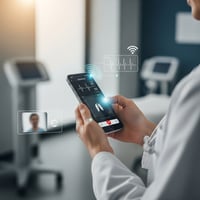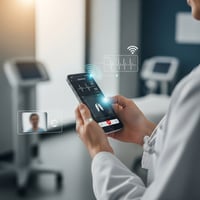Imagine someone named Riley, who navigates the world in a wheelchair. Riley often faces barriers...
Inclusive Baby Monitoring: SmartSpectra SDK Enhances Parenting Accessibility
In the heart of an accessible technology world lies the story of Sandra and Michael, new parents navigating the challenges of raising their first child, Mia, while managing their own accessibility needs. Sandra, who has limited mobility, finds traditional baby monitoring methods challenging, while Michael, who is hard of hearing, often misses the subtle sounds that indicate Mia is awake or in distress. This family’s journey underscores the vital importance of inclusive technology solutions like the SmartSpectra SDK, a promising tool in the realm of baby monitoring via camera, tailored to make parenting more accessible for everyone.
The SmartSpectra SDK represents a significant stride towards barrier removal and independence for parents with disabilities by using a phone or tablet camera to monitor an infant's breathing and movement. While this technology is not yet fine-tuned for the unique challenges presented by monitoring infants—such as smaller faces and the low-light conditions of nighttime—it offers a foundation upon which more inclusive, accessible technologies can be built. It’s crucial to note that while this innovative tool acts as a secondary aid and not a certified SIDS prevention device, its potential for enhancing parental peace of mind is immense.
Universal design principles are at the heart of making technologies like the SmartSpectra SDK truly inclusive. By considering a diverse range of users during the development process, including those with various disabilities, technologies can be designed to be more user-friendly for everyone. For the SDK, this could mean integrating features that adjust for low-light conditions or that are sensitive to the subtle movements of infants, ensuring that parents like Sandra and Michael can rely on the technology regardless of their own accessibility needs or the environment.
Implementation considerations for inclusive technologies should also address the varied ways parents may interact with alerts and information. For parents who are deaf or hard of hearing, like Michael, visual or tactile alerts could be life-changing, enabling them to respond to their baby’s needs promptly. Similarly, ensuring the app’s interface is navigable for individuals with limited mobility or dexterity, like Sandra, means features such as voice commands or customizable control layouts could be invaluable.
The specific accessibility features and benefits of a fully realized SmartSpectra SDK could revolutionize baby monitoring. Imagine a system where alerts can be set to accommodate the sensory preferences of the parent, where the monitoring is reliable even in pitch darkness, and where the data collected is interpreted with such precision that it can distinguish between a baby’s routine movements and those that warrant attention. This is the empowering potential of inclusive design—technology that adapts to the user’s needs, not the other way around.
Looking towards an inclusive future, the vision is for technologies like the SmartSpectra SDK to evolve beyond their initial limitations, becoming tools that any parent, regardless of their abilities, can rely on for peace of mind. The journey of parents like Sandra and Michael illustrates not just the necessity but the profound impact of inclusive technology. By removing barriers and fostering independence, we empower all individuals to participate fully in the most significant aspects of human life, such as raising a child. Inclusive technology isn’t just about accessibility; it’s about transforming the fabric of society to be more accepting, understanding, and supportive of everyone’s unique journey.




